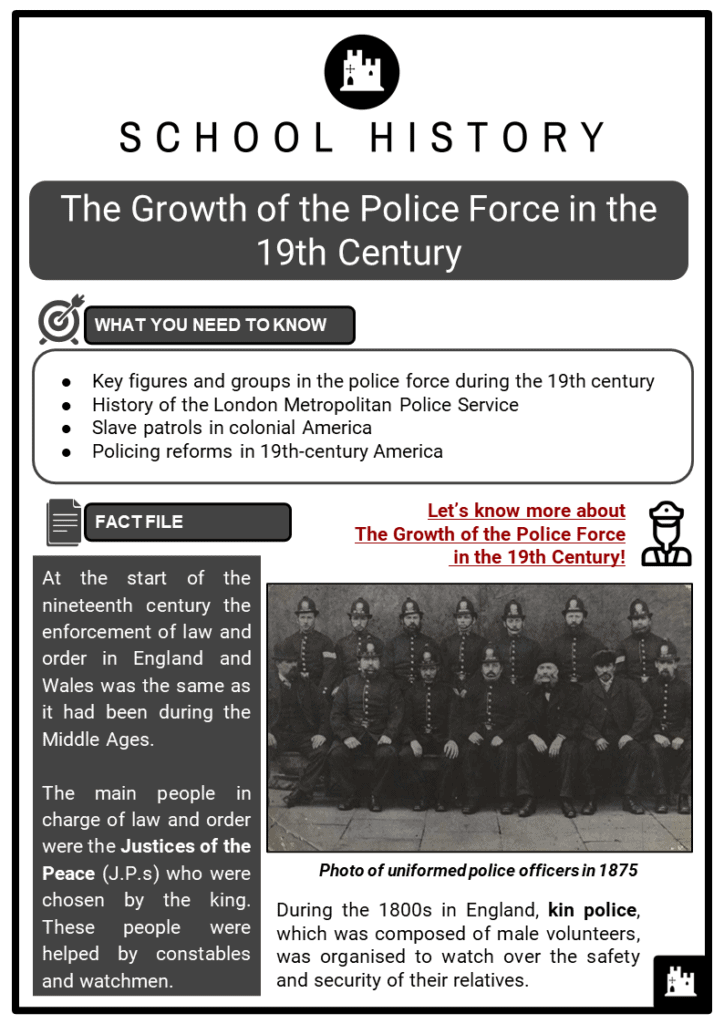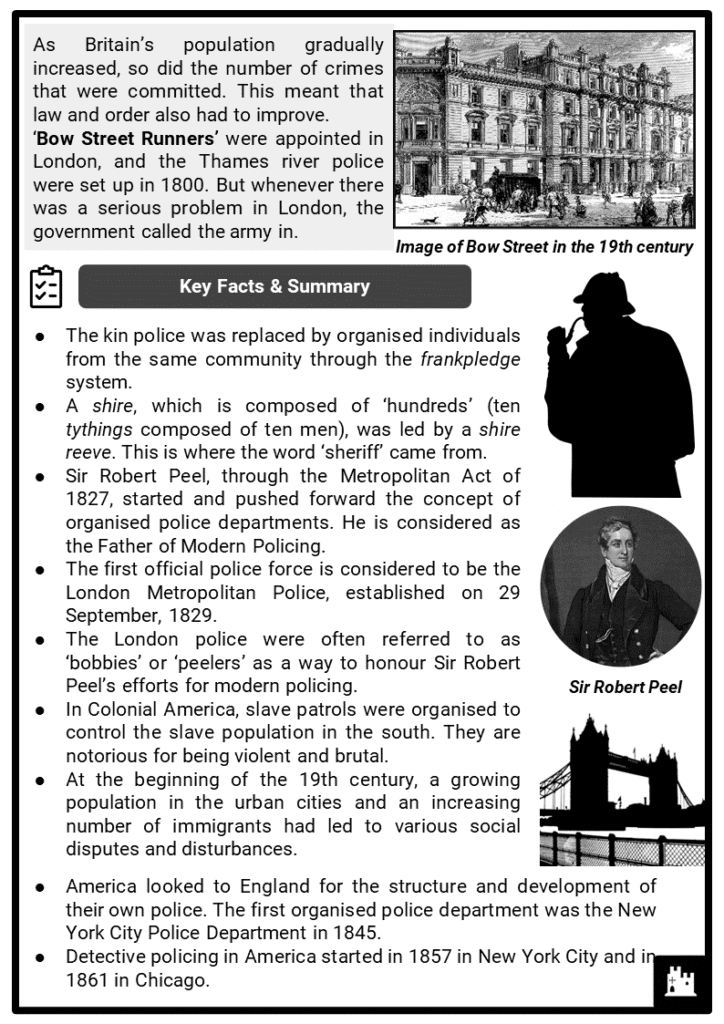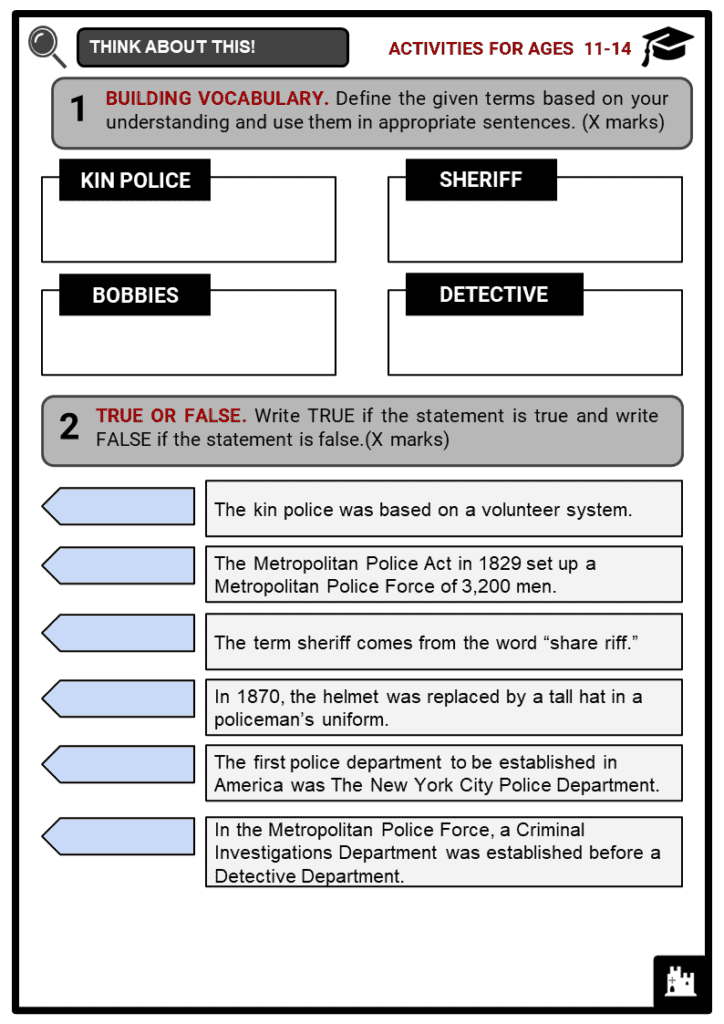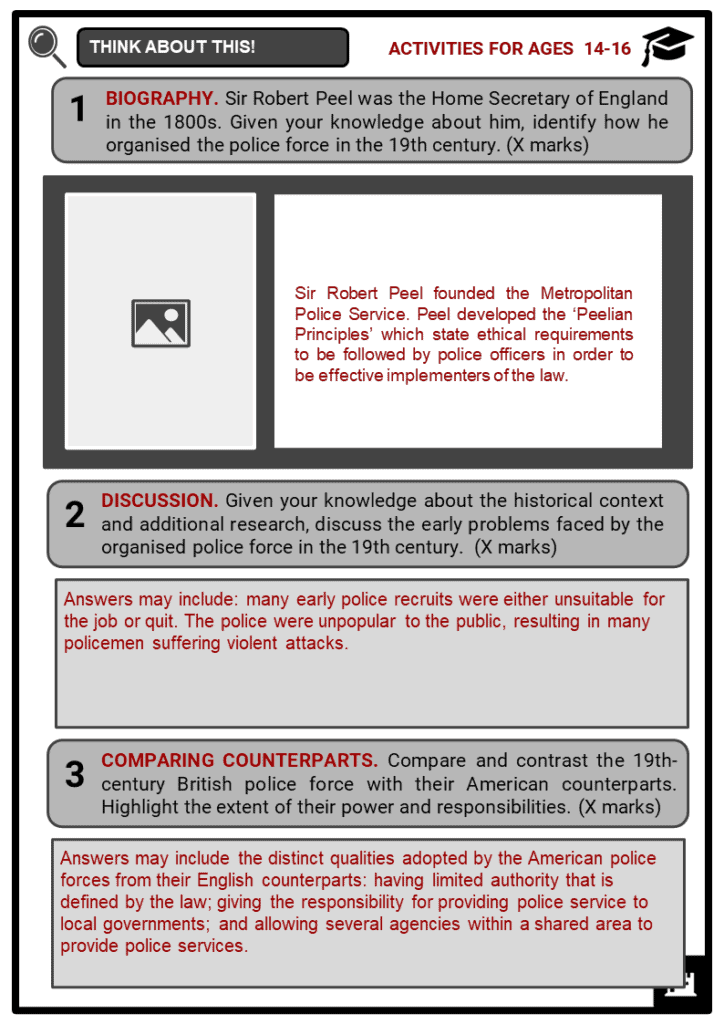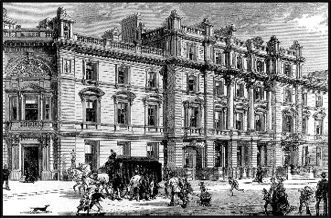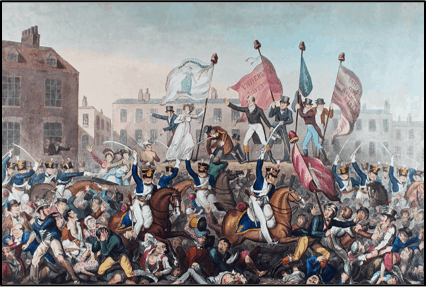Download The Growth of the Police Force in the 19th Century Worksheets
Do you want to save dozens of hours in time? Get your evenings and weekends back? Be able to teach The Growth of the Police Force in the 19th Century to your students?
Our worksheet bundle includes a fact file and printable worksheets and student activities. Perfect for both the classroom and homeschooling!
Table of Contents
Add a header to begin generating the table of contents
Summary
- Key figures and groups in the police force during the 19th century
- History of the London Metropolitan Police Service
- Slave patrols in colonial America
- Policing reforms in 19th-century America
Key Facts And Information
Let’s know more about The Growth of the Police Force in the 19th Century!
- At the start of the nineteenth century the enforcement of law and order in England and Wales was the same as it had been during the Middle Ages.
- The main people in charge of law and order were the Justices of the Peace (J.P.s) who were chosen by the king. These people were helped by constables and watchmen.
- During the 1800s in England, kin police, which was composed of male volunteers, was organised to watch over the safety and security of their relatives.
- As Britain’s population gradually increased, so did the number of crimes that were committed. This meant that law and order also had to improve.
- ‘Bow Street Runners’ were appointed in London, and the Thames river police were set up in 1800. But whenever there was a serious problem in London, the government called the army in.
Key Facts & Summary
- The kin police was replaced by organised individuals from the same community through the frankpledge system.
- A shire, which is composed of ‘hundreds’ (ten tythings composed of ten men), was led by a shire reeve. This is where the word ‘sheriff’ came from.
- Sir Robert Peel, through the Metropolitan Act of 1827, started and pushed forward the concept of organised police departments. He is considered as the Father of Modern Policing.
- The first official police force is considered to be the London Metropolitan Police, established on 29 September, 1829.
- The London police were often referred to as ‘bobbies’ or ‘peelers’ as a way to honour Sir Robert Peel’s efforts for modern policing.
- In Colonial America, slave patrols were organised to control the slave population in the south. They are notorious for being violent and brutal.
- At the beginning of the 19th century, a growing population in the urban cities and an increasing number of immigrants had led to various social disputes and disturbances.
- America looked to England for the structure and development of their own police. The first organised police department was the New York City Police Department in 1845.
- Detective policing in America started in 1857 in New York City and in 1861 in Chicago.
The London Metropolitan Police Service
- The development of American police services was largely influenced by England once being the Colonial America.
- In the early stages, kin police was practised, whereby people, mostly men, were responsible for watching out for their relatives or kin. Based on a volunteer system, the responsibilities of the kin police involved social services such as:
- lighting street lamps;
- running soup kitchens;
- recovering lost children; and
- rescuing stray animals.
- The crime control activities were very minimal. Later, kin police was replaced with the frankpledge system wherein groups of men from the same community enforce the law. Ten men formed tythings, ten of which formed hundreds, and then hundreds were grouped into shires or counties, which were led by a shire reeve, or a sheriff in modern language.
- The concept of a more organised and official police force formed by the government started with Sir Robert Peel, the Home Secretary of England, in the 1800s.
- By introducing a Bill for Improving the Police in and Near the Metropolis or the Metropolitan Police Act of 1827, the London Metropolitan Police was established on 29 September, 1829. They are considered the first modern police department in history, and Sir Robert Peel the father of
modern policing. - Peel believed that the main purpose of the police was to prevent crime rather than detecting it after it had occurred. This can be done by having a more coordinated and centralised police force, covering large areas, and being accessible to the public day and night.
- It was also Peel’s ideology of how the police force can be more credible to the public than the earlier versions through wearing proper uniforms with badges, having a military-like organisational structure, and a central headquarters accessible to the public.
Why was the Metropolitan Police Force set up?
- At the start of the nineteenth century, law and order was under constant threat. By 1829, London’s population had grown to 1.5 million, yet it only had 450 constables and 4,000 watchmen.
- London depended on the army or the local militia, and on spies and informers, to keep the peace, and to restore order during serious disturbances. The need for a preventative police force was highlighted by the Peterloo Massacre and Chartist uprisings in London. The tactics for preventing and dealing with crime in London were often inefficient and caused more problems. Added to this situation was the apparent growth in homicide, robbery, theft and burglary, all of which were increasing as a result of the Industrial Revolution.
- The first major reform of law enforcement in the nineteenth century was the Metropolitan Police Act in 1829.
- It was the work of Robert Peel, who believed that existing methods of maintaining law and order were inefficient. The Metropolitan Police Act in 1829 set up a Metropolitan Police Force of 3,200 men to cover an area extending 7 miles from the centre of London. There were 17 divisions, each with four inspectors and 144 constables.
- The police officers were soon known as ‘bobbies’ or ‘peelers’ after Robert Peel. They wore a uniform that included dark blue long coats and a tall hat. They were unarmed except for truncheons – this was supposed to make them as unlike the army as possible but left them open to vicious attacks from criminals in London. In 1870, the tall hat was replaced by a helmet similar to that worn by the Prussian army but without the spike on top.
Early Problems for the New Police Force
- There were many problems at first. Most of the early police recruits were unsuitable (often due to drunkenness) and soon resigned or were sacked. Many people – rich and poor alike – hated the police.
- Many policemen suffered violent attacks. Some people drove
their coaches straight at policemen on traffic duty – they did not
like being told what to do by somebody in uniform.
In 1833, a man who had stabbed a policeman to death during a political riot in Cold Bath Fields, was found not guilty of murder. The judge felt that the 500 ‘peelers’ brought in for crowd control had been an overreaction and that the policeman deserved to be stabbed. - Gradually Londoners began to realise that the police were having
an effect on the level of crime. This was an important factor in the
public’s approval of the new police force. - Although some politicians did exaggerate the impact of the police on organised criminal gangs in London. Apparently many criminals just left London to carry out their underhand activities more easily elsewhere.
Late Nineteenth Century Developments
- In 1842, a Detective Department was created within the Metropolitan Police. There was great suspicion about this new development and by 1848 there were still only eight plain clothes detectives – see illustration on the left. In 1869, the National Criminal Record was set up: it dealt with only the most notorious criminals.
- Communications had been sped up by the telegraph, which was introduced in 1867.
- In 1877, a Criminal Investigations Department (CID) was set up with 200 detectives: this was increased to 800 in 1883.
- Also in 1883, the Special Branch was created to deal with Irish nationalist terrorists known as the ‘Fenians’.
Slave Patrols in Colonial America
- The increase in immigrant groups in America during the 1700s led to a higher population and an increase in social disorder and unrest.
- Early watch groups were organised to pacify the racial and ethnic conflicts existing among the population. No longer able to adapt to the changing social climate, the watch groups were replaced by slave patrols or paddy rollers, whose main responsibility was to manage conflict over slave populations especially in the Southern states of America. Slave patrols, who are mostly white males, were known for their high level of brutality against the slaves. They continued to be present until the Civil War and even after slavery was ended.
- The existence of slave patrols in pre-19th century America was reflective of the close relationship between policing and politics. Politicians hired and retained police officers as a means to maintain their political power, and in return, police officers would remain employed by encouraging citizens to vote for the politicians. This made few to no standards for hiring or training police officers.
Policing Reforms in 19th Century America
- While many consider the slave patrol to be the first formal attempt at policing in America, it was the unification of police departments in several major cities during the early to mid-1800s that marked the start of modern policing in America.
- As the number of immigrants from Germany and Ireland settled in the growing urban cities of New York City and Boston, American families who were mostly from England and the Netherlands were threatened by the new cultures and lifestyles. It was the start of a growing urban unrest brought about by crime, rioting and other disturbances.
- The initial response was to set up moral and religious exemplars to immigrants and the poor through Sunday schools such as the Young Men’s Christian Association. By the mid-19th century, the frustration among the middle class had called for laws that regulate public behaviour. This included establishing asylums and police forces.
- The first police departments to be established in America were The New York City Police Department in 1845, the St. Louis Metropolitan Police Department in 1846, the Chicago Police Department in 1854 and the Los Angeles Police Department in 1869.
- Three distinct qualities from their English counterparts were adopted by the American police forces, namely:
- having limited authority that is defined by the law;
- giving the responsibility for providing police service to local governments; and
- allowing several agencies within a shared area to provide police services.
- The last one had caused problems of communication, cooperation and control among different agencies. All these characteristics are still reflected in modern American policing.
- Police power in America was strongly tied to local control over most institutions. Their main task was to prevent crime and disorder, and to provide other public services within the level of political wards and neighborhoods, which created autonomous police units.
- Being closely linked to communities and being an instrument for reforms over ethnic and economic rivalries, there existed a struggle for political control of the police. This political struggle is a dominant theme in the history of American police.
Image sources:

